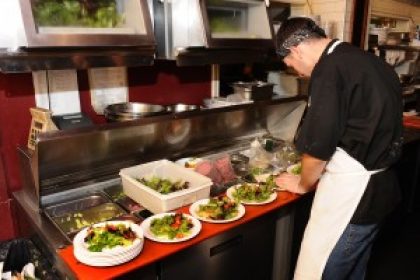
This post was originally published in The Daily Hampshire Gazette, August 29, 2017, by Claire Morenon and appeared in: CISA Opinion Pieces, News
 What comes to mind when you think of local food? Bustling farmers markets, charming roadside stands, Community Supported Agriculture barns filling with produce and customers — these are the images that spring to mind for most of us. Indeed, those direct-to customer outlets are vital to farms in the Valley, and they’re central to the culture and community here, too. However, the reality is that only about half of the food dollars that we spend in the United States go toward food which is prepared and eaten at home, and 37 percent of U.S. food dollars are spent at restaurants.
What comes to mind when you think of local food? Bustling farmers markets, charming roadside stands, Community Supported Agriculture barns filling with produce and customers — these are the images that spring to mind for most of us. Indeed, those direct-to customer outlets are vital to farms in the Valley, and they’re central to the culture and community here, too. However, the reality is that only about half of the food dollars that we spend in the United States go toward food which is prepared and eaten at home, and 37 percent of U.S. food dollars are spent at restaurants.
A thriving local food system cannot depend only on shoppers choosing local in their kitchens — it must include pathways for farmers to get their products to restaurants, along with schools and all the other places that we eat.
Happily, in our region, those connections are strong and growing. Seventy-four local restaurants have demonstrated their commitment to serving local food and supporting local farms by joining the Community Involved in Sustaining Agriculture’s Local Hero campaign this year. At CISA’s last count, in 2015, Local Hero restaurants spent a combined $2 million on local food. Chefs and restaurant owners are effusive when asked about local farms and food — the freshness and quality of the food, the fun of shaking up the menu as the seasons change, the meaningful relationships, the importance of supporting other small local business owners, and maintaining open spaces.
Still, direct relationships between local farms and local restaurants aren’t always easy. Mainstream distribution companies allow busy restaurateurs to order everything they need from only a handful of vendors and to receive deliveries any day of the week. Local farm offerings, of course, are highly seasonal and tend to be specialized, which means restaurants usually have to coordinate individually with an orchard for fruit, a dairy farm for cheese or yogurt, a beekeeper for honey, and so on. Except for those that have set up systems to work specifically with small local restaurants and retailers, most local farms aren’t able to make small deliveries multiple times a week.
It’s a significant commitment of work and time on the restaurant side to manage orders and deliveries with numerous vendors. For many, it’s a real barrier, and they rely on strong partnerships with those farms that offer the widest product ranges and can make multiple weekly deliveries. For others, managing those relationships is actually one of the perks of their jobs — Evelyn Wulfkuhle of Magpie in Greenfield told us, “It’s a gift here in the Valley to get to work with so many small-scale local farms, who are both fantastic suppliers and wonderful customers.”
Sourcing local meat poses unique challenges because of the gap between customer preferences and the realities of meat production. A restaurant may serve dozens of hanger steaks per week or thousands of chicken wings, for example, but there’s only one hanger steak per cow and only two wings per chicken—so no small-scale local farm is going to be able to meet those needs. Instead, local restaurants may choose to source only their ground beef locally, which makes up a significant percentage of the meat on a cow. And some dedicated chefs buy whole animals and shape their menus accordingly.
Some local farm products simply can’t compete on price. For some local restaurants, this means that they focus on sourcing the products that do fit into their budget, like in-season produce. For others, like Molly Feinstein of GoBerry in Amherst and Northampton, managing local pricing is an ongoing balancing act. She said, “The reality is that good sourcing makes a good product, but the milk and yogurt we buy directly from local farms is more expensive. We want to pay a fair price to our distributors and we understand their expenses. But customers are price sensitive so there’s a balance of providing value and being profitable.”
Despite all the complications, there is a lot of genuine enthusiasm for local food and a real commitment to supporting local farms among local chefs. And that enthusiasm is met on the farmer side, too. Here’s Danya Teitelbaum, farmer at Queen’s Greens in Amherst: “Restaurant menus are so flexible and creative and they’re always changing, and the chefs get so excited when a new crop comes in. I love going to the restaurants we sell to and seeing how they use our produce! It’s part of what we love about the Valley —there’s something special about how the businesses around here work together.”
So, when you decide to take a break from the kitchen, look for those restaurants that support local farms and enjoy their creative use of the harvest. Who knows — you might even run into the farmer who grew your dinner!
Claire Morenon is the communications manager at Community Involved in Sustaining Agriculture in South Deerfield.




